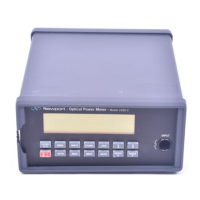26
5.5.3 General Guidelines for Using the GPIB Port
The GPIB port can communicate with computers and other devices that
have GPIB ports that follow the IEEE 488.1 standards. Third party add-on
boards and software can be used to allow a personal computer to commu-
nicate with the 1830-C through the IEEE 488 port. With these add-on boards
and software, high-level language programs, can also be written to control
the 1830-C through the IEEE 488 port. For those who wish to minimize the
need for conventional “programming”, Newport provides free instrument
driver software for plug-in-and-run compatibility with LabVIEW.
Call Newport for more information.
Some of the issues which should be kept in mind while developing the
IEEE 488 software interface for the 1830-C, are as follows:
• A query is a command that invokes a response from the 1830-C. All
queries are terminated with a question mark (?).
• Since the 1830-C’s output buffer size is limited to ten bytes, it is recom-
mended that the response to a query be read before other commands
are issued.
• Before reading the response, the MAV bit in the status byte should be
checked by means of a serial poll to make sure that the data is available.
(See Appendix A, Status Reporting System)
• Only one command/query may be sent to the 1830-C per bus transaction.
5.5.4 Procedure for Reading Only New Measurements
When you want to retrieve only new measurements from the GPIB bus, use
the following sequence of commands, serial polls, and queries:
1) Send the Command: C
This will clear the status byte register.
2) Serial Poll the 1830-C until the Read Done bit goes high. (decimal 128)
3) Send the Query: D?
This is a Data Query and responds with the last signal acquisition.
4) Serial Poll until the Message Available (MAV) bit goes high. (decimal 16)
5) Perform a GPIB read.

